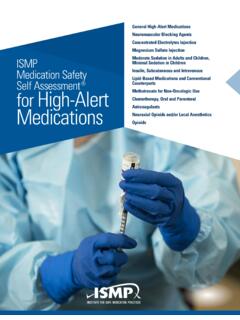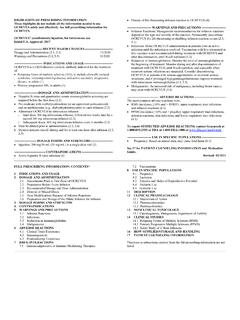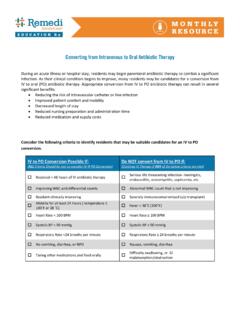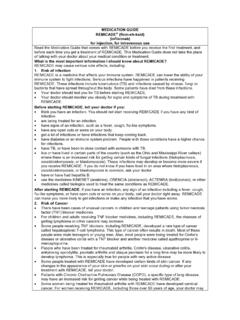Transcription of INTRAVENOUS FUROSEMIDE PROTOCOL FOR HEART FAILURE
1 Sharon Andrews INTRAVENOUS FUROSEMIDE PROTOCOL FOR HEART FAILURE Authors Sharon Andrews & Lucy Girdler-Heald with guidance from Caroline Cooper Reviewed by: Dr Swinburn, Dr Gadgil, Dr Howard, Dr Pizura Adult Services Improvement Group on 21st June 2013 Medicines Management Group CCG Medicines Management Approved by: BHFT Medicines Management Group Date approved: 17th September 2013 Review date: Reviewed 12/08/2015 Sharon Andrews This PROTOCOL is to be read in conjunction with BHFT Policies:- CCR126 INTRAVENOUS Therapy for Adults & Children in non acute settings ICC002 Hand Hygiene ICC003 Personal Protective Equipment ICC005 Management of Sharps, Inoculation and Needlestick Injury INF008 Policy for the Safe Handling and Disposal of Sharps (West CHS) ICC005 Guidance on Sharps/Contamination Injury (West CHS)
2 ICC008 Single Use Medical Devices ICC009 Blood and Body Fluids Spillage ICC010 Safe Collection, Handling and Transportation of Laboratory Specimens ICC018 Aseptic Technique CCR049 Medical Devices Training CCR006 Care and Control of Medicines CCR119 Guidelines for Continuous Subcutaneous Syringe Drivers used in Adult Palliative Care CCR035R Consent to Examination and/or Treatment All staff that administer INTRAVENOUS using the INTRAVENOUS route must have received training and been assessed as set out in this policy. Nurses must be registered with the Nursing and Midwifery Council. Sharon Andrews Aim The predominant symptoms of worsening HEART function, breathlessness and worsening oedema are due to congestion.
3 Currently, if increased oral diuretics fail to improve symptoms when the patient is at home, they are admitted to hospital for INTRAVENOUS (IV) diuretic treatment. The goal of IV diuretic treatment is to relieve congestion and associated symptoms. IV diuretic treatment can be administered in the community to suitable patients under the supervision of the specialist HEART FAILURE nursing team as an alternative to a hospital admission. Suitable patients may be identified by any member of the multi-disciplinary HEART FAILURE team. The background to HEART FAILURE should be consistent with the natural history of the patient s disease trajectory. Congestion should not be due to another reversible cause FUROSEMIDE would not be the only treatment required for patients with uncontrolled atrial fibrillation, bradycardias, sepsis, thyroid disease, anaemia, significantly worsening renal function etc.
4 The referring clinician needs to ensure that reversible causes of cardiac decompensation have been excluded. Inclusion and Exclusion Criteria see below The patient should be fully involved in the decision to have this service. They need to understand the nature of the treatment and agree management of the IV diuretic plan with their HEART FAILURE Specialist Nurse (HFSN). Patients would need to have sufficient mobility to be able to get to and from a toilet, or a commode, and a means of emptying it would need to be provided. An agreed decision about urinary catheterisation for bed-bound patients would need to be taken.
5 Frequency of administration and dose of IV diuretic- see below although this may be tailored to a specific patient on discussion with the lead physician. Patient screening Inclusion criteria Documented or estimated weight gain of > 3 kgs: Associated with peripheral oedema and/or orthopnoea Despite adherence to optimal oral diuretic Not attributable to other cause Agreement to administer bolus with lead clinician Clarification of baseline medication Adequate social arrangements to manage IV therapy Sharon Andrews Exclusion criteria Baseline creatinine > 250 umol/l Baseline sodium < 125mmol/l Baseline potassium [K+] < or > mmol/l Systolic blood pressure (BP) < 90mmHg Evidence of acute coronary syndrome or haemodynamically significant arrhythmia Significant abnormality of liver function (3x normal level of AST or ALT) or low serum protein levels.
6 Patient declined Patient lacking capacity to consent Concomitant medication Prior to commencing infusion: Discontinue existing prescribed oral loop diuretics. Continue other HEART FAILURE medications (ACEI or ARB) and beta blocker at baseline dose unless adjustment was indicated clinically.. Safety thresholds for intervention STOP INTRAVENOUS therapy if: Target weight/desired weight loss and symptoms improvement achieved (efficacy threshold) Creatinine > 50% above baseline or > 300 umol/l Potassium [K+] < or > mmol/l Systolic blood pressure (BP) < 85mmHg (if symptomatic) Discuss with lead physician & consider admission to hospital REDUCE INTRAVENOUS therapy if: Reduce bolus dosing and consider alteration to medication and discussion with lead physician if: Sharon Andrews Creatinine > 250 umols/L Consider reduction in ACEI or ARB dose Potassium [K+] < or > mmol/l.
7 Consider K+ supplement if K+ low or reduction in ACEI or ARB dose if high. Systolic blood pressure (BP) <90 mmHg (if symptomatic) Consider (if postural hypotensive symptoms despite being fluid overloaded) reduce/stop vasodilators, reduce ACEI or ARB dose, reduce beta-blockers Routine observations Before IV diuretic therapy the following need to be undertaken : Baseline FBC, urea and electrolytes, creatinine, liver function tests including albumin, thyroid function tests. Daily recording of blood pressure, pulse, symptoms, weight and cannula inspection Daily U&Es if requested by the consultant cardiologist , otherwise to have U&Es every other day Post IV diuretic schedule medication On completion of IV diuretic treatment the oral diuretic should be prescribed by the Independent Nurse Prescriber, the Lead Physician or the GP Weight and fluid status will need to be closely monitored and oral diuretic dose may need to be further adjusted.
8 Doses of ACEI (or ARB) and beta blocker may have been adjusted and may thus require re-optimisation. Both changes made to medication and arrangement to re-optimise medication should be documented in post IV diuretic correspondence to GP and copy of which should be retained within the patient record. Sharon Andrews INTRAVENOUS FUROSEMIDE PROTOCOL FOR HEART FAILURE This PROTOCOL refers to the treatment of the HEART FAILURE patient who is retaining fluid despite optimal care. This will present clinically as: Increased oedema and symptomatic and or Gain in weight of> 3kgs greater than base-line weight Despite o Optimal doses of oral diuretic o Fluid restriction to < litres/day and on a low salt diet INTRAVENOUS FUROSEMIDE should be given as a once fixed-dose bolus until target weight loss is achieved: Cannulation in accordance with CCR126 INTRAVENOUS Therapy for Adults & Children in non-acute settings Day 1: Bolus dose of FUROSEMIDE 80 mg.
9 Days 2-4: Continue at FUROSEMIDE 80 mg once daily If diuresis of >2 litres or weight loss of > 2kg per day reduce to 40 mg once daily Day 4: Review/discuss with supervising physician: Discontinuation of bolus dose On-going bolus dose with incremental increase ( twice daily bolus) On-going bolus dose with the addition of an adjunctive diuretic to enhance diuresis ( metolazone, bendroflumethiazide or spironolactone) Admission to hospital STOP IV FUROSEMIDE if: Target weight/desired weight loss and symptoms improvement achieved (efficacy threshold) Safety threshold crossed On clinical advice On clinical advice: A higher initial IV diuretic dose may be considered in individual patients in whom effective dosing was known from prior treatment.
10 On clinical advice from the lead physician, IV FUROSEMIDE may be offered to palliative patients for symptom relief if they have expressed that their preferred place of care/death is at home. Sharon Andrews Berkshire Healthcare NHS Foundation Trust Pharmacy Department Hospital / Dept Pharmacy Department, Prospect Park Hospital Standard Operational Procedure Number INJSOP FUROSEMIDE Page 7 of 13 Title: Procedure for administering INTRAVENOUS FUROSEMIDE Dated: May 2013 Reviewed: August 2015 To be reviewed: August 2017 Written by: Sharon Andrews Approved by: Procedure for administering INTRAVENOUS FUROSEMIDE Purpose: To safely administer IV FUROSEMIDE as per manufacturer s information and prescribers calculations on the prescription.







